Getting a nice "six-pack" or "toned" abs is a top priority for many of our fitness boot-camp or personal training clients. When a new client comes in for a consultation, we ask them to state their top 2 goals so we can help them reach these goals. A nice set of abs or a "strong core" is often at the top of the list.
However, there are several big myths when it comes to ab training and getting a nice, firm midsection. I will explain what these three myths are, and at the end I will give a sample ab training workout that trains your abs in a safe, and science based way.
While there is a lot of good information on the Internet, the amount of information has also increased a lot, making it more difficult for a reader to tell the difference between what is correct and what is not.
Myth 1 - You should use an unstable surface for 'core' training
One of the main myths of "core" training is that you should use an unstable surface because it makes the training "harder" and your "core" has to activate to do the exercise.
An example of this is doing squats on a vibration plate or on a swiss ball. These surfaces do make the exercise harder, but this is because the unstable surface makes it harder to keep your balance, NOT because your core muscles work more.
In fact, studies show that, apart from a situation where we are trying to rehabilitate an injured client, unstable surfaces are a bad idea. This is because the body senses the shaking, and switches off the muscles you are trying to train (the legs and buttocks in the case of squats) so you can't lift as much weight, and cant get as much benefits. This is a protective mechanism. After all, it is dangerous to exercise during an earthquake.
So Myth 1 is that you should not confuse unstable surface training, which trains your BALANCE, with training for a nice hard set of abs.
Balance is something that is learned as a child during play. If you are 40 years old, your balance is not able to improve much. However, using the exercises at the end of the article, you should still be able to get a strong set of core muscles regardless of age.
Myth 2 - Sit-ups are the best way to get a nice set of abs
This myth is based on the assumption that your abs get really tired from sit-ups, and since your abs are the most "visible" of the core muscles, sit-ups must be good for you.
Much of the de-bunking of this myth has been done by Dr Stuart McGill at the University of Waterloo. He is probably the worlds no.1 researcher in lower back and core issues. He spends a lot of his time with pig spines (the pigs are already dead don't worry) trying to find the best ways to injure them, so we can learn about the best ways to prevent humans from injuring their backs.
One of the best ways he found to injure a spine is to flex and extend it repeatedly, and to injure it even faster, rotate it at the same time! That's what many people do when the perform fast, uncontrolled situps with a twist!
In fact, much of Dr McGills' research points to the fact that most of our core muscles, are design to resist movement rather than create movement.
So myth 2 is that lots of twisting and situps is a great idea for your abs. In fact, if done excessively, its a great way to hurt your back.
Myth 3 - Spending lots of time on ab training will give you great looking abs
Most people love to train abs. Fitness corners and gym around Singapore are full of people doing all kinds of ab training.
A recent study at the University of Southern Illinois took 2 groups of people and had one group do lots of core training for about an hour, five days per week. Exercises like crunches, situps, leg lifts etc.
The other group had the easy job of NOT training.
The group that trained had a great increase in endurance, they could do about 50 percent more situps in a minute than the non-training group. But they had little chance in their waistlines, overall bodyfat or abdominal fat!
Their time would have been much better spent on a proper whole body-conditioning, resistance-training program which, combined with a good nutrition plan of unprocessed meats, veggies and fruit, would certainly have decreased their abdominal fat.
From experience, even this increase in endurance has a diminishing effect. After about 6-8 weeks of core training, you hardly get any benefits. The only way to make your core muscles stronger after six weeks of direct training, is to use more and more load in basic exercises like overhead presses and squats.
So to avoid myth 3 -- do some core work, but after 6 weeks, focus on becoming stronger overall for the best benefits.
Sample workout
Below is a sample beginner and advanced training program to add to the end of your 3x a week training sessions. So if you train Mon, Wed, Sat... Mon would be day 1, Wed would be day 2, and Sat would be day 3.
Remember to do these at the END of your workouts because tiring your core muscles at the beginning can be a cause for injury. Chris will demonstrate the exercises.
Beginner
- Day 1: Front Bridge
- Keep your core braced. That means that you tense up your butt, lower back and abs as if someone is going to "punch" you in the stomach.
- Hold this position for 30 seconds. As you improve, extend this time to 60 seconds.
- Repeat 4 times
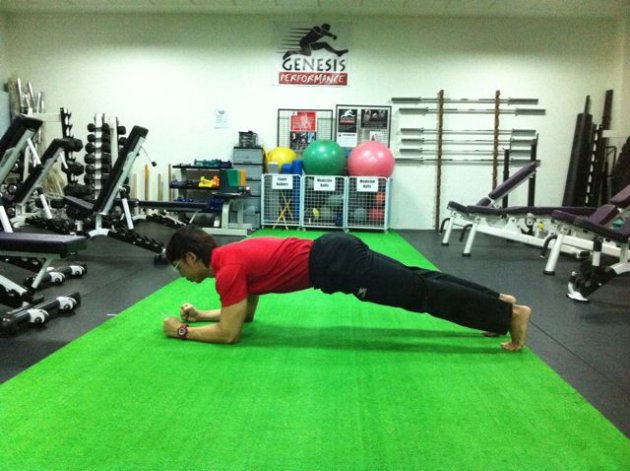
Core training exercise (Coach Jon)
- Day 2: Swiss Ball Crunch
- Keeping your core braced, extend yourself across the swiss ball. Don't let yourself flop around. Stay in control by bracing.
- Curl up till you are fully "crunched" hold the top position for 1 second. Then lower yourself under control in four seconds.
- Repeat 10 times for four sets.
- As you improve, hold a dumbbell across your chest for added resistance.
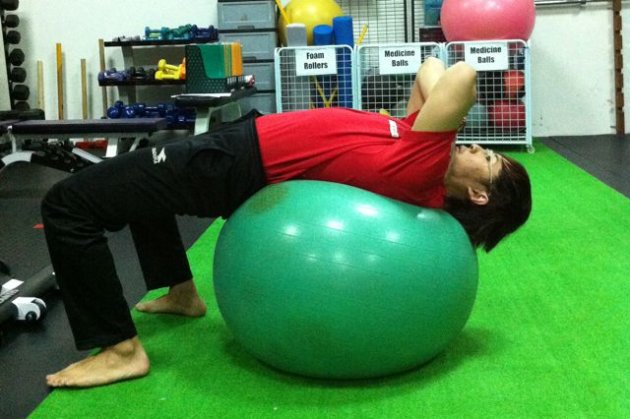
Core training exercise (Coach Jon)
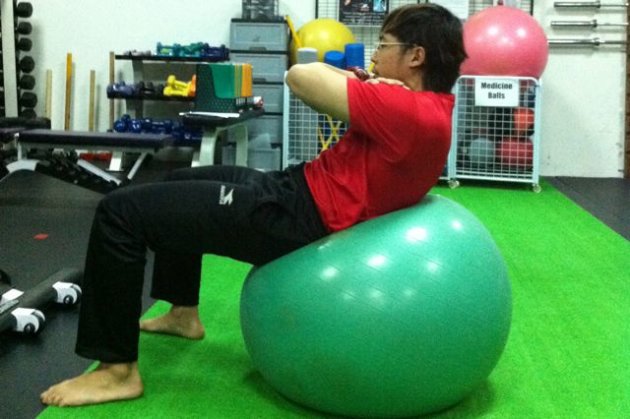
Core training exercise (Coach Jon)
- Day 3: Side Bridge
- Keep your head, hips and knees in line while bracing your core. Don't bend forward at the waist.
- Hold for 30 seconds, work up to 60 as you improve.
- If this is too hard for you, try the variation in the picture below with your knees on the floor.
- Perform three sets per side
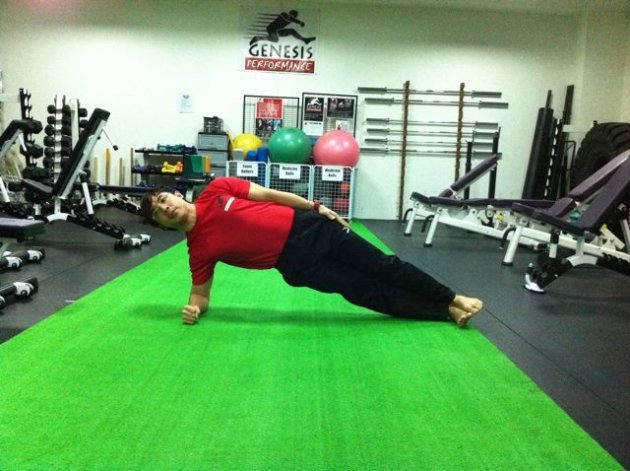
Core training exercise (Coach Jon)
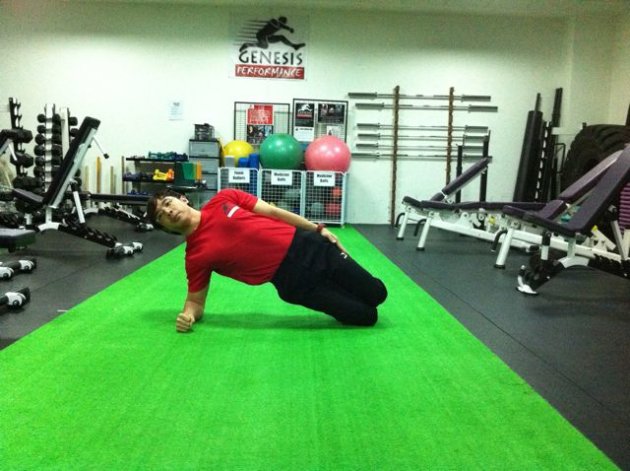
Core training exercise (Coach Jon)
Advanced
- Day 1: Hanging Garhammer Raise
- Start with knees raised till legs are parallel to the ground. Knees are bent and big toes should point inwards till they touch each other. This keeps the hip flexors out of the exercises, and focuses the effort on the lower fibres of your abs.
- Curl your legs up as high as you can, and try to hold the top position (its hard!) then lower under control in 1-2 seconds.
- Stop in the start position. Don't let your legs drop lower than that.
- Immediately repeat 10-12 times
- Perform four sets
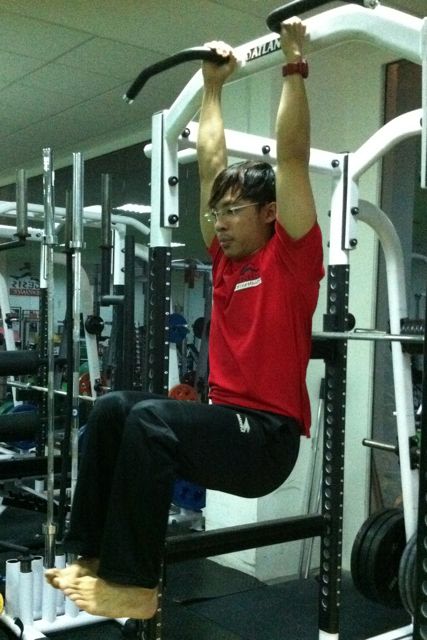
Core training exercise (Coach Jon)
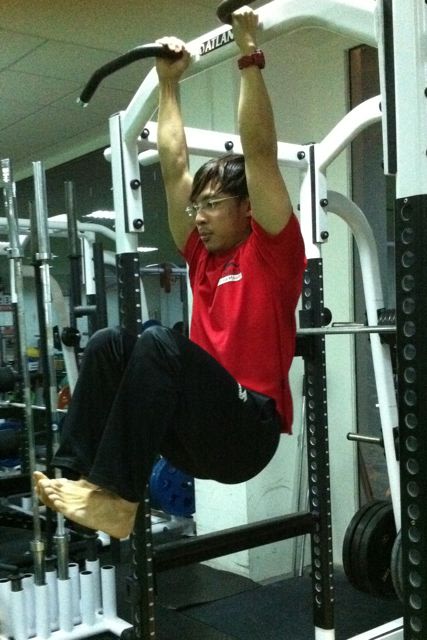
Core training exercise (Coach Jon)
- Day 2: Suitcase Walk/Lift
- Pick up the weight in one hand and walk (or just stand if you don't have space) for 30 seconds. Increase this to 60 seconds as you improve. Once you reach 60 seconds, increase the weight.
- Keep your body totally upright. This trains the core in resisting movement from side to side which protects your back, and is the primary function of the core muscles.
- Repeat four times
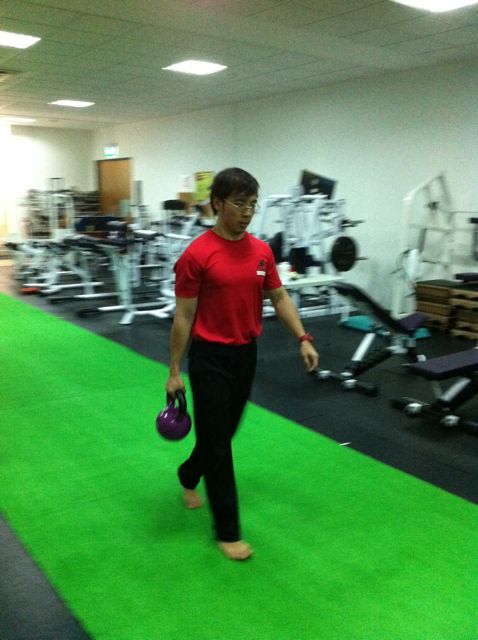
Core training exercise (Coach Jon)
- Day 3: Roman Twist On Swiss Ball
- Keeping your core braced, move a dumbbell or medicine ball to one side.
- The lower back should hardly move. It should be tight and braced. The main movement should come from your chest area. This trains your core to resist rotational movement, another of its key functions.
- Slowly move the ball to the other side in four seconds, holding the end position for two seconds.
- Repeat 10 times for four sets.
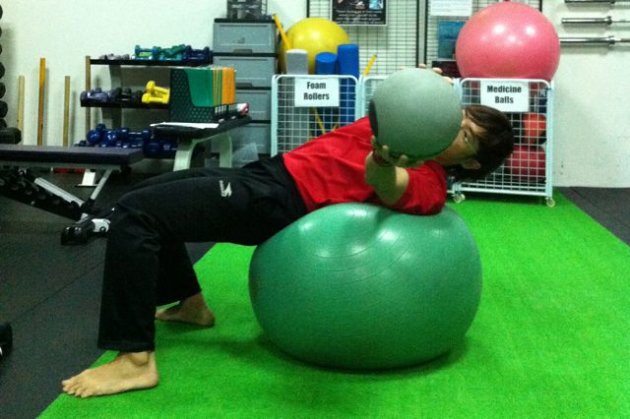
Core training exercise (Coach Jon)
There we have it. Two workouts that will get you stronger abs. Just remember, do each set for about 3-4 weeks, and then that would be enough core training for a while. Performing a challenging strength training program after that would keep and improve the core strength you gained from these 6-8 weeks of workouts.
Coach Jonathan Wong is a Singapore personal trainer and health expert. He is also a fitness author and a member of Singapore Men's Health Advisory Panel.
For the best personal training and top indoor fitness boot camp program in Singapore visit www.coachjon.com
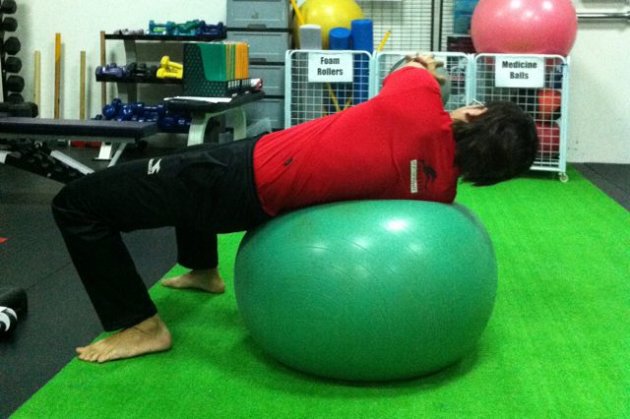
No comments:
Post a Comment